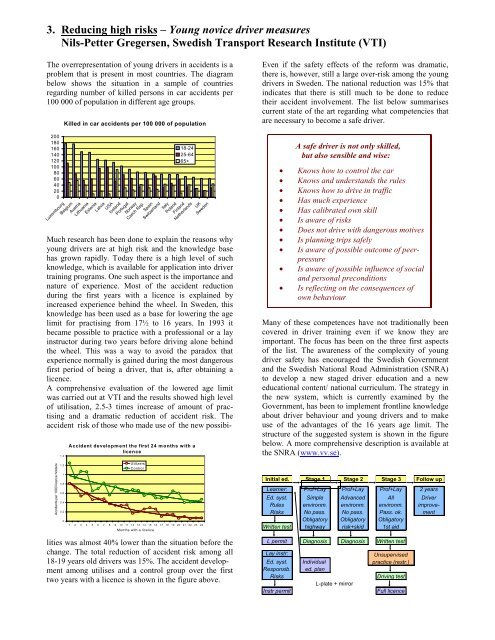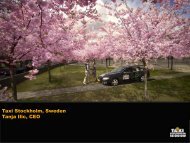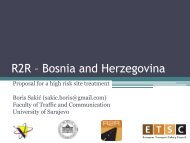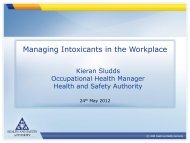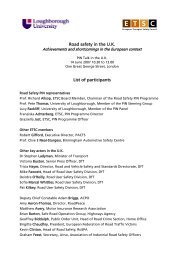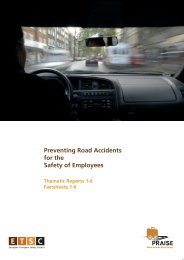BEST IN EUROPE ROAD SAFETY CONFERENCE - ETSC
BEST IN EUROPE ROAD SAFETY CONFERENCE - ETSC
BEST IN EUROPE ROAD SAFETY CONFERENCE - ETSC
Create successful ePaper yourself
Turn your PDF publications into a flip-book with our unique Google optimized e-Paper software.
3. Reducing high risks – Young novice driver measures<br />
Nils-Petter Gregersen, Swedish Transport Research Institute (VTI)<br />
The overrepresentation of young drivers in accidents is a<br />
problem that is present in most countries. The diagram<br />
below shows the situation in a sample of countries<br />
regarding number of killed persons in car accidents per<br />
100 000 of population in different age groups.<br />
200<br />
180<br />
160<br />
140<br />
120<br />
100<br />
80<br />
60<br />
40<br />
20<br />
0<br />
Luxembourg<br />
Belgium<br />
Killed in car accidents per 100 000 of population<br />
18-24<br />
25-64<br />
65+<br />
Austria<br />
Lithuania<br />
Estonia<br />
Latvia<br />
USA<br />
Iceland<br />
Portugal<br />
Norway<br />
Czech Rep.<br />
Spain<br />
Switzerland<br />
Italy<br />
Poland<br />
Finland<br />
Netherlands<br />
UK<br />
Sweden<br />
Much research has been done to explain the reasons why<br />
young drivers are at high risk and the knowledge base<br />
has grown rapidly. Today there is a high level of such<br />
knowledge, which is available for application into driver<br />
training programs. One such aspect is the importance and<br />
nature of experience. Most of the accident reduction<br />
during the first years with a licence is explained by<br />
increased experience behind the wheel. In Sweden, this<br />
knowledge has been used as a base for lowering the age<br />
limit for practising from 17½ to 16 years. In 1993 it<br />
became possible to practice with a professional or a lay<br />
instructor during two years before driving alone behind<br />
the wheel. This was a way to avoid the paradox that<br />
experience normally is gained during the most dangerous<br />
first period of being a driver, that is, after obtaining a<br />
licence.<br />
A comprehensive evaluation of the lowered age limit<br />
was carried out at VTI and the results showed high level<br />
of utilisation, 2.5-3 times increase of amount of practising<br />
and a dramatic reduction of accident risk. The<br />
accident risk of those who made use of the new possibi-<br />
Accidents per 1000 licence holders<br />
1.4<br />
1.2<br />
1<br />
0.8<br />
0.6<br />
0.4<br />
0.2<br />
0<br />
Accident development the first 24 months with a<br />
licence<br />
Utilizers<br />
Control<br />
1 2 3 4 5 6 7 8 9 10 11 12 13 14 15 16 17 18 19 20 21 22 23 24<br />
Months with a licence<br />
lities was almost 40% lower than the situation before the<br />
change. The total reduction of accident risk among all<br />
18-19 years old drivers was 15%. The accident development<br />
among utilises and a control group over the first<br />
two years with a licence is shown in the figure above.<br />
Even if the safety effects of the reform was dramatic,<br />
there is, however, still a large over-risk among the young<br />
drivers in Sweden. The national reduction was 15% that<br />
indicates that there is still much to be done to reduce<br />
their accident involvement. The list below summarises<br />
current state of the art regarding what competencies that<br />
are necessary to become a safe driver.<br />
A safe driver is not only skilled,<br />
but also sensible and wise:<br />
• Knows how to control the car<br />
• Knows and understands the rules<br />
• Knows how to drive in traffic<br />
• Has much experience<br />
• Has calibrated own skill<br />
• Is aware of risks<br />
• Does not drive with dangerous motives<br />
• Is planning trips safely<br />
• Is aware of possible outcome of peerpressure<br />
• Is aware of possible influence of social<br />
and personal preconditions<br />
• Is reflecting on the consequences of<br />
own behaviour<br />
Many of these competences have not traditionally been<br />
covered in driver training even if we know they are<br />
important. The focus has been on the three first aspects<br />
of the list. The awareness of the complexity of young<br />
driver safety has encouraged the Swedish Government<br />
and the Swedish National Road Administration (SNRA)<br />
to develop a new staged driver education and a new<br />
educational content/ national curriculum. The strategy in<br />
the new system, which is currently examined by the<br />
Government, has been to implement frontline knowledge<br />
about driver behaviour and young drivers and to make<br />
use of the advantages of the 16 years age limit. The<br />
structure of the suggested system is shown in the figure<br />
below. A more comprehensive description is available at<br />
the SNRA (www.vv.se).<br />
Initial ed. Stage 1 Stage 2 Stage 3 Follow up<br />
Learner: Prof+Lay Prof+Lay Prof+Lay 2 years<br />
Ed. syst. Simple Advanced All Driver<br />
Rules environm. environm. environm. improve-<br />
Risks No pass. No pass. Pass. ok. ment<br />
Obligatory Obligatory Obligatory<br />
Written test highway risk+skid 1st aid<br />
L permit Diagnosis Diagnosis Written test<br />
Lay instr:<br />
Unsupervised<br />
Ed. syst. Individual<br />
practice (restr.)<br />
Responsib. ed. plan<br />
Risks<br />
L-plate + mirror<br />
Driving test<br />
Instr permit Full licence


